-
current
recommendations- Liefdefjord
New page dedicated to one of Spitsbergen's most beautiful fjords. Background information and many photos.
- New Spitsbergen guidebook
The new edition of my Spitsbergen guidebook is out and available now!
- Liefdefjord
New page dedicated to one of Spitsbergen's most beautiful fjords. Background information and many photos.
Page Structure
-
Spitsbergen-News
- Select Month
- May 2025
- April 2025
- March 2025
- February 2025
- January 2025
- December 2024
- November 2024
- October 2024
- September 2024
- August 2024
- July 2024
- June 2024
- May 2024
- April 2024
- March 2024
- February 2024
- January 2024
- December 2023
- November 2023
- October 2023
- September 2023
- August 2023
- July 2023
- June 2023
- May 2023
- April 2023
- March 2023
- February 2023
- January 2023
- December 2022
- November 2022
- October 2022
- September 2022
- August 2022
- July 2022
- June 2022
- May 2022
- April 2022
- March 2022
- February 2022
- January 2022
- December 2021
- November 2021
- October 2021
- September 2021
- August 2021
- July 2021
- June 2021
- May 2021
- April 2021
- March 2021
- February 2021
- January 2021
- December 2020
- November 2020
- October 2020
- September 2020
- August 2020
- July 2020
- June 2020
- May 2020
- April 2020
- March 2020
- February 2020
- January 2020
- December 2019
- November 2019
- October 2019
- September 2019
- August 2019
- July 2019
- June 2019
- May 2019
- April 2019
- March 2019
- February 2019
- January 2019
- December 2018
- November 2018
- October 2018
- September 2018
- August 2018
- July 2018
- June 2018
- May 2018
- April 2018
- March 2018
- February 2018
- January 2018
- December 2017
- November 2017
- October 2017
- September 2017
- August 2017
- July 2017
- June 2017
- May 2017
- April 2017
- March 2017
- February 2017
- January 2017
- December 2016
- November 2016
- October 2016
- September 2016
- August 2016
- July 2016
- June 2016
- May 2016
- April 2016
- March 2016
- February 2016
- January 2016
- December 2015
- November 2015
- October 2015
- September 2015
- August 2015
- July 2015
- June 2015
- May 2015
- April 2015
- March 2015
- February 2015
- January 2015
- December 2014
- November 2014
- October 2014
- September 2014
- August 2014
- July 2014
- June 2014
- May 2014
- April 2014
- March 2014
- February 2014
- January 2014
- December 2013
- November 2013
- October 2013
- September 2013
- August 2013
- July 2013
- June 2013
- May 2013
- April 2013
- March 2013
- February 2013
- January 2013
- December 2012
- November 2012
- October 2012
- September 2012
- August 2012
- July 2012
- June 2012
- May 2012
- April 2012
- March 2012
- February 2012
- January 2012
- December 2011
- November 2011
- October 2011
- September 2011
- August 2011
- May 2011
- April 2011
- March 2011
- February 2011
- January 2011
- December 2010
- November 2010
- September 2010
- August 2010
- July 2010
- June 2010
- May 2010
- April 2010
- March 2010
- February 2010
- November 2009
- October 2009
- August 2009
- July 2009
- June 2009
- May 2009
- April 2009
- March 2009
- February 2009
- January 2009
- December 2008
- November 2008
- October 2008
- August 2008
- July 2008
- June 2008
- May 2008
- April 2008
- March 2008
- February 2008
- April 2000
- Select Month
-
weather information
-
Newsletter

| Guidebook: Spitsbergen-Svalbard |
Home →
Yearly Archives: 2018 − News
Fishing vessel in maritime distress in Hinlopen Strait
A fishing vessel got into serious trouble in Hinlopen Strait in northern Svalbard, as the SAR central in north Norway informed. The Norwegian ship “Northguider” had raised the alarm at 1322 hours (local time) today (Friday), whereupon the SAR machinery in Longyearbyen and north Norway was put into operation. Soon, both rescue helicopters went up in Longyearbyen, the first one arrived on scene at about 1515 hours, less than 2 hours after the alarm bell had rung in the SAR central in north Norway. At the same time, an Orion aircraft took off from Andøya in Norway. Depending on the exact type, these aircraft may be used in SAR missions for example to search for missing vessels or persons or to survey potential oil spills.
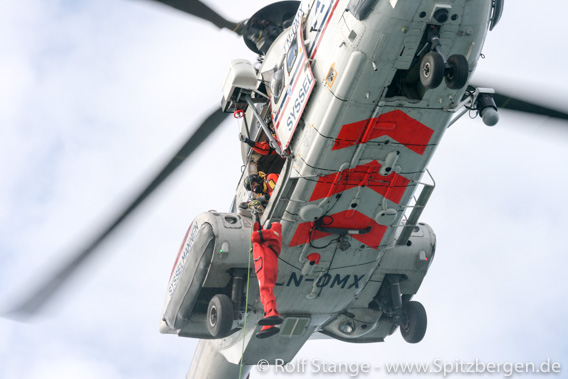
SAR helicopter of the Sysselmannen, here seen during an exercise.
But the good news is that all persons seem to be well. The crew of 14 have dressed up in survival suits and gone to the bow area to be picked up by the rescue helicopters. According to the ship owner, all persons are supposed to be well, at least considering the circumstances. Nobody is injured or has been in cold water.
The Northguider appears to have hit the ground on the coast of Nordaustland south of Murchisonfjord. She is now sitting on the ground and listing with 20 degrees but the position seems to be stable so far. The weather – about 18 degrees centigrade below freezing, darkness and strong wind (Beaufort 6) – makes the rescue operations challenging, but there is no reason to believe that the Norwegian SAR professionals are not able to get all crew members off soon.
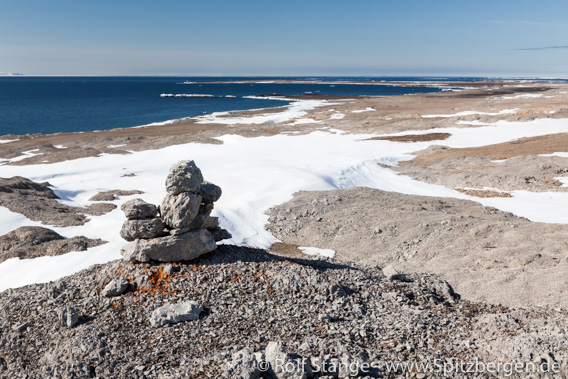
Kalkstranda in Hinlopen Strait, south of Murchisonfjord: the Northguider is supposed to have run aground somewhere here. Conditions there are quite different from the photo now, with darkness, cold and wind.
The coast guard ship KV Barentshav has set course for Hinlopen Strait, but is not expected to arrive there before Saturday. Polarsyssel, the Sysselmannen’s service ship, is not available in Spitsbergen in wintertime.
Update: the SAR central North Norway informs that all 14 persons were taken into the helicopters and are by now taken care of in Longyearbyen. The Northguider is still sitting on the ground, taking in water.
With new Spitsbergen panoramas into the new year
In 2018, again I had plenty of opportunities to shoot arctic panoramas, making these interesting and beautiful (well in some cases, it is interesting or beautiful) easily accessible for everybody. Physically, most of them are pretty much inaccessible for most people. A panorama photo does not physically take you to, say, a mountain top on Prins Karls Forland, but it is the next best thing – it gives you the feeling to be in the middle of the landscape, you can just turn around and enjoy the full view of the arctic landscape.
Over 5 years now, the by far largest digital museum of Spitsbergen (Svalbard) has thus come into existance. And it keeps growing. It takes quite some time and effort to turn the 18 RAW files (35, in some cases) into one panorama and to make that part of a dedicated little website or even to turn many panoramas into one virtual tour, such as the school / kindergarten in Pyramiden. In many cases it has taken years for material to progress on the list to the point where it actually appears on the website.
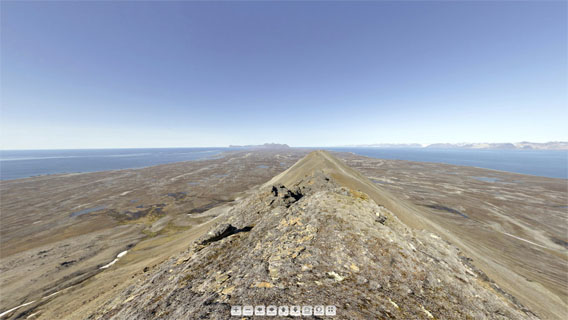
New Spitsbergen panoramas: the round view from Persiskammen, in the southern part of Prins Karls Forland, is just one out of many
(this here is just a screenshot without panorama function).
Here is a choice of new Spitsbergen panoramas that we have made during the last couple of months and weeks – a little Christmas-/New Years’s present for the Spitsbergen community:
- Pyramiden: School / Kindergarten. In October the whole collection of Pyramiden panoramas had moved to a dedicated little map so you can find your way around as you take a little walk through the old ghost town, possibly visiting a building here and there. And we added some new panoramas, including the school / kindergarten, which is our largest single virtual tour so far – the building has 3 floors! Other new ones include the old mines.
- Barentsburg: also here we did not just add new material, but we sorted the panos on a dedicated map, so you know where you are. New panoramas include the brewery, Lenin, the chapel, …
- And while we were at it, of course also Ny-Ålesund had to get its own map to make the whole thing proper. And also here we took the opportunity to add some new panoramas, including Amundsen, the Kongsfjordbutikken, the museum, the Green House, the airshipmast, …
- Let’s get out of the settlements and into the wilderness. Murraypynten is a point on Prins Karls Forland with some fine views.
- Another one on Prins Karls Forland. Nesungen is on the outer side of the island, which is exposed and rarely visited.
- Last but definitely not least from Prins Karls Forland. The view on Persiskammen, this lonesome mountain in the south of the island, is just stunning!
- Elfenbeinbreen in Agardhdalen, not far from the east coast.
- Buchholzbukta is not far from Heleysund, as far east on the main island of Spitsbergen as you will get.
- Polhem in Mosselbukta was Nordenskiöld’s base during his 1872-73 wintering.
- Foxfonna is a little ice cap close to mine 7. Amazing winter views in central Nordenskiöld Land.
- Rijpsburg on Bohemanflya is not just the site where the first commercial coal mining took place in Spitsbergen. It is also a beautiful place.
- Finally back again to civilisation. The taubanesentrale (coal cableway centre) is one of Longyearbyen’s eye catchers. Normally it is closed, but here and now … – welcome in!
- One of Spitsbergen’s most difficult-to-get-to places is the famous Global Seed Vault). Once again: welcome in!
Enjoy – and happy new year!
Why Santa Claus’ reindeer come from Spitsbergen. And why this can’t be true.
Christmas is a time of love, family and healthy food. Presents, trees and… mystery. Or do you know how Santa Claus manages to visit far more than a billion children around the globe? Even if you take those out who have been naughty or who maybe don’t want (or are not allowed to) have anything to do with Christmas – there is still a lot of work to do for the old man.
Sharon George of the Keele University in England has done some science to find answers to such questions. She proposes that Santa Claus pulls some quantum physics tricks out of his bag. Just Quantum tunnelling alone may reduce the distance he has to travel by something near 50 %.
Do I hear you shout “yes, of course, I should have known”?
But still, Father Christmas has to make his way at a breakneck speed of 15,625 kilometres per hour (9,708 mph), to get everything done that is on his impressive to-do list. According to George, he makes good use of bundling the shock waves of the thunder that comes from breaking through the sonic wall. Something happens shortly after some initial scratching of the snow with the hooves by the reindeer, as they have to be 10 times faster than sound to get things done.
It is safe to assume that the sledge is made of some nickel-titanium alloy to survive the mechanical challenges that come with such travelling. Friction between air and the nose of the very first reindeer will heat the latter up until it is glowing red-hot, a fact that readily explains some anatomic particulars of Rudolf the red-nosed reindeer.

Merry Christmas! Drawing by Norbert Wachter from the book Arktische Weihnachten.
So far, so good. But then the scientist makes a mistake as she says that Santa Claus’ reindeer, including the famous, above-mentioned Rudolf, come from Spitsbergen. She argues that only the Spitsbergen reindeer is small and leightweight enough so it can wait on the roof of any house while the boss is kreeping down the chimney to get his job done. Any other – heavier – reindeer would just break through the roof, something that might bring the schedule of the whole operation into some serious trouble.
As plausible as this may seem – it can’t be true. Why? This is something that the present author has discussed in his book “Arktische Weihnachten” (German only, sorry!). The relevant text section comes at the end of the book and it is agailable here (click to download).
Just in case you don’t read German: reflect for a moment about when male reindeer shed their antlers. Yes, it’s after the mating season, which is in late September and into October. This means that male reindeer from the northern hemisphere don’t have big antlers at Christmas. Rudolf and his colleagues have to come from the southern hemisphere!
Where would that be? Well, the whalers introduced Norwegian reindeer to South Georgia. But there, they were killed off some years ago. A stock was, however, preserved in the Falkland Islands. So the simple truth is: Santa Claus’ reindeer come from the Falkland Islands! And so does probably the man himself, as he has to take care of his reindeer also the rest of the year, doesn’t he?
Happy Christmas!
Bank robbery in Longyearbyen: first details about the offender
The man who tried to rob the bank in Longyearbyen on Friday is a 29 years old Russian citizen who does not live in Longyearbyen, as the Sysselmannen stated in a press release. The man is now in Tromsø for an initial 4 weeks for investigative custody.
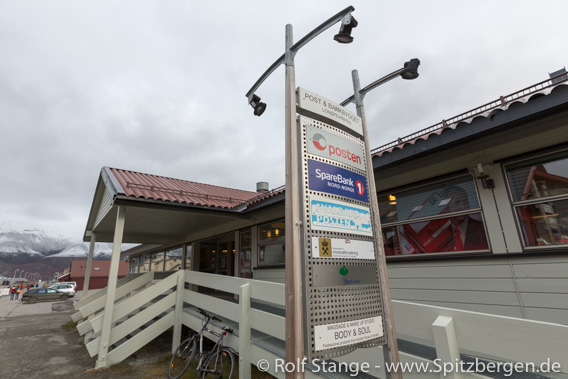
First details about Friday’s bank robbery: The offender is a 29 year old Russian and not a local.
The prize is confiscated, it is said to be a sum of NOK 70,000. During the hold-up, the man had threatened the 3 bank employees with a Mauser rifle which he had legally rented in Longyearbyen. Weapons of this type are commonly rented by tourists from local weapon dealers for polar bear protection.
Next to bank robbery, the man is now also accused for violation of the weapon law and threatening with a firearm.
No further information regarding the offender or the deed have been released as of now. Sysselmann Kjerstin Askholt regrets in a statement that types of crime are now observed in Longyearbyen that have previously been unknown locally and that crime is developing together with the general changes of the local society on Svalbard.
Bank robbery in Longyearbyen
No, this is not a joke, unfortunately: there was a bank robbery in Longyearbyen today (Friday, 21 December). The alarm went in the Sysselmannen’s office at 10.40 local time. One man entered the bank with a firearm and brought some cash in his control.
There were only employees in the bank at that time. These took proper action and managed to activate the alarm, as the Sysselmannen told Svalbardposten.
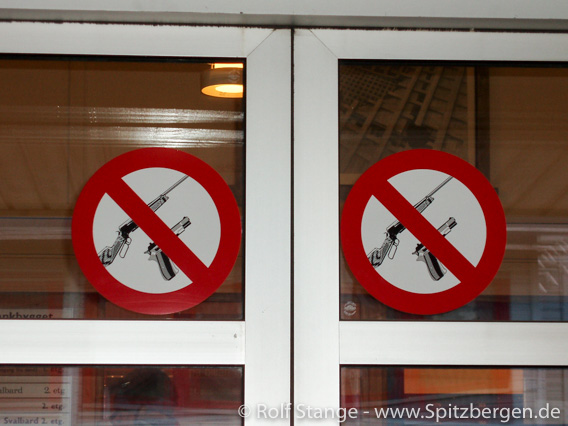
It is actually forbidden to enter the building with the bank in Longyearbyen with a firearm. Today, there was a bank robbery. Nobody was injured.
The bank robber was soon arrested by the police, he still had the money with him. He is not of Norwegian nationality and was taken to see the medical doctor, but police questioning is expected to begin later today.
Update: it was not a local resident. The man will be taken to Tromsø today for investigative custody.
No further information is available so far.
Walrus population is growing in Spitsbergen
Good news about arctic wildlife populations – do they exist? There is, of course and for good (or, rather, bad) reason, a lot of attention on climate change and how polar bears and other species will cope with life in a world with less and less ice.
But then there are also walrusses (click here for some general information about these lovely animals). Several colonies in the Spitsbergen area (Svalbard) are monitored with automatic kameras to follow the numbers of animals coming and going. Results so far indicate a growing population and the pleasant observation that walrusses are not bothered by tourists. It is rather the occasional polar bear who is seriously disturbing resting walrusses – these ruthless polar bears just don’t keep the minimum distances.
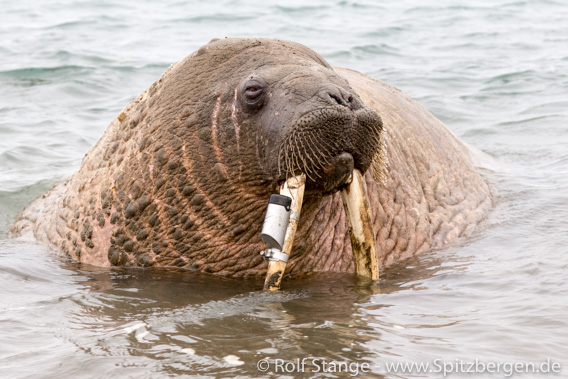
Walrus with satellite sender, Edgeøya.
Additionally, some walrus are equipped with satellite senders to follow migration patterns. This is important to establish which percentage of the total population in an area is resting on shore while the others are in the water. Data show that about 25 % of the walrusses are resting on show while the majority of 75 % is swimming.
This knowledge makes the number of walrus seen at the colony sites on shore a good indication for the total regional population. Censuses are made roughly every 5 years with small planes equipped for the purpose. They follow the coastline in an altitude of 1000 feet (a good 300 m) while taking photos. Previous counts were made in 2006 and 2012 and the most recent one followed in August 2018. All colonies are surveyed in a time frame as short as possible to make sure individuals are not counted twice ase they may make visits to friends and colleagues at other resting places.
86 colonies were surveyed in Svalbard in August 2018. The number of walrus observed varied from 0 in many cases to a maximum of 269.

Walrus colony on Moffen.
And what is the result? The number of walrusses present in the whole of Svalbard in August 2018 was estimated between 5031 and 6036 individuals. Nailed down to one figure, the population size is 5503 animals, as was reported noy by Christian Lydersen, Magnus Andersen, Jade Vacquie Garcia, Samuel Llobet and Kit Kovacs (Norwegian Polar Institute) in an article in Svalbardposten. This is 42 % more than counted the last time in 2012. A very positive development! But no surprise if you consider that walrusses were hunted almost to regional extinction until protection finally came in 1952. The current growth of the population is still a reaction to the end of hunting, just as with the polar bear population in the same area.
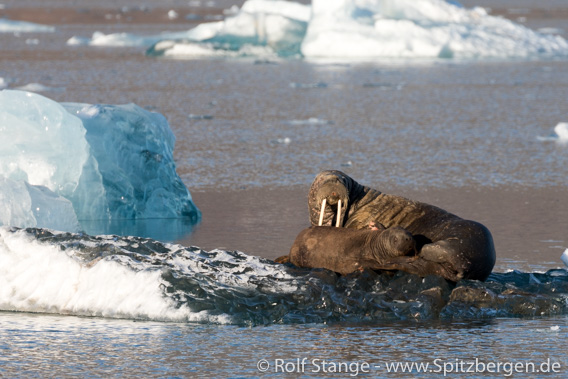
Walrus cow with calf: beautiful symbol for a growing population.
It will, however, take many more decades before the population will be even remotely near original levels, if this ever happens again.
Rock legend Robert Plant comes to Longyearbyen
There are still those who think that Longyearbyen is a lonely, silent place where a few coal miners and trappers live. Reality is quite different: there is a well-established and vibrant cultural scene. Next to some very active local clubs and artists, there is a number of festivals and events that have by now established international reputation. This includes the Jazz Festival and the Dark Season Blues Festival (both in the beginning of the polar night) and events such the Ski Marathon and Spitsbergen Marathon, which all attract large and still growing numbers of visitors from many different countries.
But rock legends who have filled the largest venues of the globe for decades do usually not have Longyearbyen on their tour plan. This will change in June 2019 when Robert Plant comes to Longyearbyen for two concerts. Plant became a rock legend with the band Led Zeppelin in the 1970s. Following “Zep’s” breakup in 1980, Plant has remained an active musician to this day.
On 27 and 29 June, Robert Plant and his band Sensational Space Shifters will be live on stage in the Kulturhuset in Longyearbyen. This is, according to Svalbardposten, a result of the work of a year of Jim Johansen and his company Walrus AS. A key factor for the success of the negotiations is said to be Plant’s personal curiousity about one of the northernmost concert locations in the world (possibly outstaged by Pyramiden – maybe they get the Rolling Stones on stage there in 2030 or so?).
Longyearbyen: The most expensive port in the world?
From 2019, large cruise ships will have to pay twice as high harbour fees in the port of Longyearbyen than they did this year. A few days ago, Longyearbyen’s harbour master Kjetil Bråten announced that the price increase is a tool to regulate mass tourism and at the same time to generate higher income. He would even like Longyearbyen to become “the most expensive port in the world” due to its remote location and the extraordinary operating costs. Ship tourism to Spitsbergen is on the rise: in 2016, 75,000 cruise passengers went ashore in Longyearbyen, compared to 15,000 in 2010.
The harbour fee Longyearbyen will in the future be based on the size of the ship. Ships with more than 100,000 gross registered tons will have to pay twice as much, namely 1.68 NOK (about 0.17 Euro) instead of 0.84 NOK per ton. In addition, the port will charge a fee of NOK 25 (approx. 2.60 Euro) per passenger instead of NOK 23.
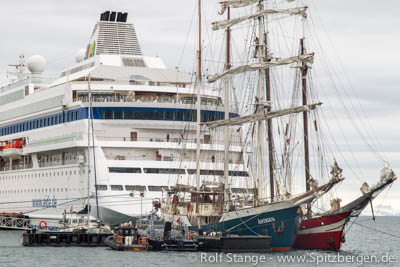
Big ships, small ships: SV Antigua versus a cruise ship
This will affect, for example, the cruise liner MSC Preziosa, which, according to its own homepage, delights its 3,500 passengers with staircases decorated with “Swarovski diamonds”. MSC Preziosa has announced its arrival in Longyearbyen in 2019 and will then have to pay a total of 940.000 NOK (around 96,000 euros) more than in 2018.
Smaller boats will also be affected by the higher fees. But since the fee depends on the size of the boats the price increase is highest for the large cruise ships. In addition, preference will be given to ships whose passengers support the local economy on their shore leaves.
However, harbour master Kjetil Bråten believes that the large luxury ships will not necessarily be deterred by the higher fees. This is not the primary goal. According to Bråten, it is rather a question of finding a balance between regulating mass tourism and generating the income needed to develop the port infrastructure and promote the local economy.
Who knows, perhaps MSC Preziosa will have to scratch a few diamonds from the railing to pay the port dues in Longyearbyen?
Interesting side note: According to a survey amongst 739 readers conducted by the local newspaper Svalbardposten, 60 percent agree with the statement that Longyearbyen should no longer accept cruise ships at all.
Source: Svalbardposten
Evacuations in Longyearbyen due to avalanche risk
It has almost become a painful tradition: the evacuation of dwelling houses in Longyearbyen at times of avalanche risk. The white danger was brought back into public attention very abruptbly in December 2015 when a snow avalanche from the mountain Sukkertoppen destroyed a number of houses and killed two people. Further houses were destroyed during another avalanche in February 2017; this time, it was only a matter of luck that nobody was hurt.
Since then, measures are taken to prevent further accidents, including rather drastic ones. Avalanche protection constructions have been established on the slopes of Sukkertoppen. The destroyed houses were not repaired. On the contrary, nearby houses are now regularly evacuated at times of avalanche risk. Depending on the risk at each individual address, some houses are only evacuated when there is an acute risk, while others are closed during the whole avalanche season.
On Thursday (29 November), an avalanche warning was issued on varsom based on weather forecasts that predicted a lot of snow. Consequently, the Sysselmannen reacted by issuing evacuations for a number of houses.
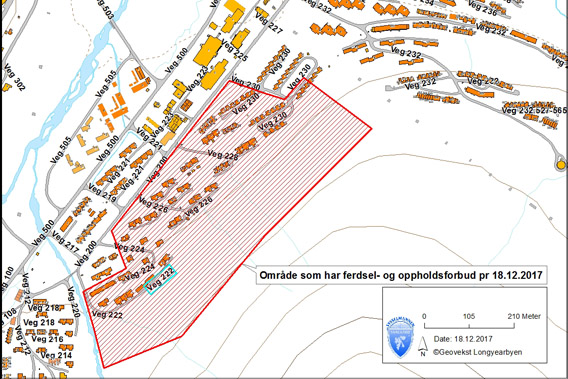
Evacuation map of December 2017. The houses closed last Thursday were within the same area.
Some evacuations have already been lifted based on a new avalanche risk evaluation by NVE, the Norwegian authority responsible for managing avalanche risks (who release warnings on varsom.no). Others will be kept up during the whole avalanche season. Visit the Sysselmannen’s website for information on which addresses are concerned.
Nach einer neuen Gefahreneinschätzung durch NVE sind die Evakuierungen teilweise bereits wieder aufgehoben worden. Besonders gefährdete Häuser in den Wegen 222 und 226 werden aber von nun an über den gesamten Winter gesperrt bleiben. Genaue Informationen zu den betroffenen Adressen gibt es bei Sysselmannen.
It is up to those concerned to find new accommodation – not an easy task considering the difficult housing market in Longyearbyen.
Good times for mine 7
Mine 7, the last Norwegian coal mine in Spitsbergen still active, has a history of 52 years – quite impressive for a coal mine and certainly more than most others in Svalbard. And it looks like 2018 will be the best of these 52 years. The amount of coal produced is above expectation and so are the coal prices on the world market.

Day plant of mine 7 in Adventdalen, 12 km southeast of Longyearbyen.
The 2018 production in mine 7 was scheduled to amount to 130,000 tons, a quantity that was already reached in October, as Svalbardposten reported.
But even more important than the good production is the development of world market prices. In spring 2018, less than 40 US-$ were paid for a ton of coal. Since then, the price has more than doubled and has now stabilised between 95 and a good 100 US-$. This development has helped mine 7 to the best year in its history, economically. Good reason for the 40 miners to be happy – and to welcome 4 more colleagues in their team soon.
The main customers for mine 7 coal are the local power plant in Longyearbyen and a German company called Clariant which is buying 60,000 tons per year. For both, the price is based on the average price of the last 3 years, giving both the producer, Store Norske Spitsbergen Kullkompani, and the customers planning reliability.

The coal mines Svea Nord and Lunckefjellet at Sveagruva were finally closed in 2016. Currently, Store Norske could probably make good profit in Svea.
This good economical development gives the decision of the Norwegian government to discontinue mining in Sveagruva, where a new mine was fully prepared in Lunckefjellet but never put into productive operation, an extra bitter taste, seen from the perspective of the Store Norske Spitsbergen Kullkompani and their employees. Many miners lost their jobs after this decision – which was based on economical reasoning. Instead, large amounts of money will now be spent on a large clean-up in Sveagruva. The recent development is likely to fuel the debate about the future of mining in Svea, a discussion that the government in Oslo officially has declared as closed.
Barentsburg-Panoramas now newly sorted and accessible through a map
The dark season in the Arctic is a good period to get desktop table projects done which have been waiting already for too long. Such as getting the collection of 360 degree panoramas from Barentsburg sorted, which until now had been cramped together on just one page, making it difficult especially for those who had not been to Barentsburg in real life to understand there whereabouts. Now, nagivation is much easier, as all places have got their own individual page and now the brewery “Red bear”, the hotel, Lenin, the old museum in the Culture House, the chapel and other sites are accessible through a map which provides easy orientation.

Barentsburg Panorama: Lenin in focus.
Click here to access the map with the Barentsburg panoramas and enjoy your virtual tour!
Energy and heating in Longyearbyen: heating like hell
Energy consumption in Longyearbyen is high above the average in mainland Norway.
Heating is provided in Longyearbyen by long-distance heating from the coal power plant, and the locals are generous when using this precious resource. The reason is not only the cold climate, which in fact is not even that much colder in the maritime climate of Spitsbergen compared to continental parts of Scandinavia. Bad insulation of buildings is amongst the main reasons. Longyearbyen was a mining settlement for much of its history and the buildings were originally intended for use during shorter periods only rather than by a more or less permanent local population. This is reflected by cheap and simple construction methods where insulation was obviously not a priority. Many buildings in Longyearbyen date back to years before 1970, and Norwegian building regulations did not come into force in Spitsbergen before 2012. Building quality may be changing quite quickly now, as many older houses have to be abandoned due to avalanche risks and a lot of houses will be built in the years to come.
Additionally, the energy consumption and heating habits of many locals are not exactly characterized by ambitious energy-saving. Some are said to open the window rather than turn the heating down. Thermostats are the exception rather than the rule. Heating costs are based on living space rather than actual consumption. And many live in flats provided by their employers, who also covers the running costs.

Heating in Spitsbergen: large oven, poor insulation.
Many inhabitants consider Longyearbyen and their own life and habits as environmentally friendly, but reality may be different, looking at electricity use, heating and traffic habits. If people in Longyearbyen were heating as people in mainland Norway do, energy consumption related to heating would drop by about 40 %. In winter, the potential to save energy is even higher, as reported in an article in Teknisk Ukeblad.
Also regarding electricity, matching local habits to mainland manners would reduce the consumption quickly by 15 %. Passive houses would increase the reduction to an impressive 25 %.
The next years may bring improvement due to the high current construction activities. Technical possibilities to improve insulation of existing houses are also work in progress.
So is the primary energy production in Longyearbyen. The only thing that is clear is that the current coal power plant will not be the long-term solution, but nobody knows what is to come then. Many options have been discussed over many years, including a new coal power plant, gas, possibly combined with renewable energy (wind? Solar power? ..?) and even a cable to the mainland. A decision has not yet been made.
Prison sentence for disturbing polar bears in Billefjord by driving car on ice
A Norwegian court has delivered a judgement in the case of a man who disturbed polar bears in Billefjorden earlier this year by driving on the fjord ice by car.
The 58 year old Ukrainian citizen was living and working in Pyramiden. He went out on the fjord ice by car to pick up two colleagues who had been on tour. Instead of going directly back to Pyramiden, they decided to take a turn into neighbouring Petuniabukta to check the condition of a hut. According to the driver, he was not aware of the presence of two polar bears who were mating at the time in question. He saw the bears at a distance of 50 metres and stopped immediately. The polar bears abandoned their mating.
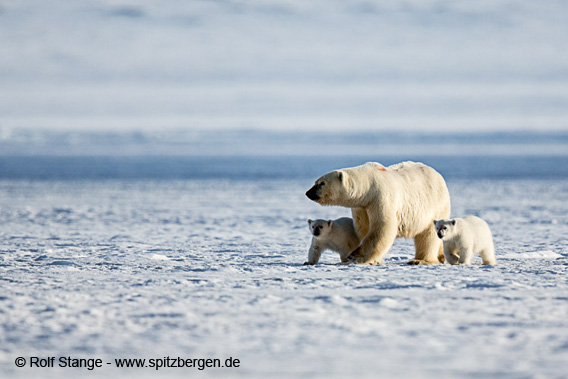
Polar bear family on fjord ice in Isfjord.
The Ukrainian driver did not have a driver’s license, this had been withdrawn by Norwegian authorities earlier this year because of other traffic offences. According to the Sysselmannen, this contributed to the current court judgement, together with the fact that it is generally not allowed to drive a car on fjord ice (or anywhere else other than on roads) in Spitsbergen. Disturbing of the polar bears alone would not have been sufficient for a prison sentence.
The man was sentenced to 30 days of prison without probation.
Longyearbyen: a great place to live, but a tough place to live
The times are currently mostly calm in Longyearbyen and Spitsbergen otherwise. There, is, of course, always something that catches public attention. The phaseout of coal mining in Sveagruva and the clearup of a whole little settlement is a discussion and will remain so for quite some time. Some buildings may be protected as part of Spitsbergen’s cultural heritage, others will probably be removed. The question of potential further use of the infrastracture in Sveagruave, within science, tourism or whatever, is still largely open. The only thing that is clear is that the whole project will cost a lot of money, just as opening the mine at Lunckefjellet, which has never seen anything but years of costly standby operations between opening and shutting down the mine.
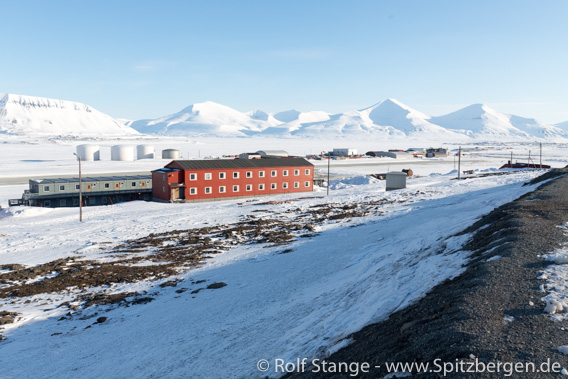
Sveagruva: a mining settlement in phaseout.
A woman in Longyearbyen is accused for having thrown a stone at a guest of Huset (a popular pub/disco/night club) during a late hour visit in March. The man received minor injuries.
A helicopter had to rescue to students from Sarkofagen, a mountain close to Longyearbyen. The two hikers had ventured into a steep slope and were unable to move any further or back.

The mountain Sarkofagen close to Longyearbyen.
Things that happen in a little arctic village after the end of the busy summer season, at the onset of the polar night. Most make themselves comfortable at home, taking care of normal everyday business and enjoying calm days as it is getting darker outside.
But not everybody can enjoy cosy evenings at home. The housing market in Longyearbyen has been difficult for years. There are several reasons for this, including avalanches which have rendered whole streets unsuitable for living in recent years. Airbnb is another issue, that makes some homes unavailable to long-term residents in need of housing. This has happened in many places in the world, but in Longyearbyen, you can’t just move to the next village somewhere near town and commute to work. At least, an important houseowner has recently announced that he does not want to rent flats out through Airbnb. Investor Fredrik Eken told Svalbardposten that his 84 flats in Longyearbyen will not be available on the mentioned platform for reasons economical rather than political or ethical.
Many flats and houses in Longyearbyen are owned by major institutions and employers such as the Sysselmannen, municipal administration, UNIS and others who need to offer housing to their employees, which is understandable but at the same time making a significant proportion of the local housing market unavailable to the public.
The local administration has done hers to make the situation more difficult, at least for some, than might be necessary. In Longyearbyen, there is a number of houses, most of them in “Sjøområdet” close to the fjord, which have flats. These flats are, however, not approved for permanent use, but rather for leisure use only. Some of these “leisure time flats” (fritidsbolig, as they are called in Norwegian) have, however, been used more or less permanently for years. In recent years, the local administration including the fire department have pushed to take more drastic measures to kick people out of these flats. Last week, representatives of the local administration and the fire department went on an unheralded control mission to some houses in question, as Svalbardposten reported. This led to 6 persons losing their accommodation on a short warning: they were given 24 hours to move out.
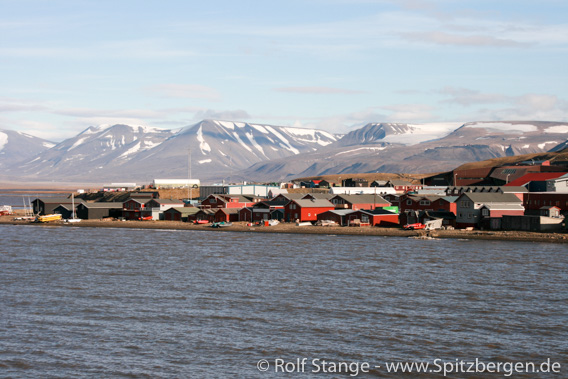
The area called “Sjøområdet” in Longyearbyen. Six people were recently removed from flats that are not approved for permanent use.
Reasons given for such rather drastic measures are mainly fire safety, followed by the missing approval for using the houses for permanent living in the use zoning plan.
It will not surprise that this approach is met by criticism and desparation amongst those concerned. Those who lived in these houses for years knew that their prolonged stay was not legal, but it was not a matter of choice for some at least. The private housing market does simply not provide affordable accommodation. Some of the 6 currently concerned will have to stay at friends’ places, becoming what is locally referred to as “sofa people”. Possibilities to find an affordable place to live in Longyearbyen on a long-term basis? Do hardly exist.
Considering this, the current approach of the municipal administration to remove people from flats that are at least approved for short-time use appears controversial. The administration has announced further controls as needed.
Fire safety can be taken care of by technical measures, and a use zoning plan is a matter of political decision making. The administration has at least announced to start a process that may include possibilities to legalize the practice.
Sounds extremely promising, doesn’t it? But it won’t help those who need a place to stay there and now. The polar night is coming, and Longyearbyen is a very dark and cold place during the winter.
Guidebook Spitzbergen-Svalbard: new German edition out now
The guidebook Spitsbergen-Svalbard, available in English, Norwegian and German, is the most comprehensive Spitsbergen book available. It is used by tourists as well as professional guides and expedition leaders, who often refer to it as the “Spitsbergen bible”. A wording that may seem to be quite far-reaching, but the author (Rolf Stange) is happy to take it as a compliment to the book.
After the first Norwegian edition came out in in 2017 and the 4th updated English edition in spring 2018, it was time for an updated German edition. The 5th edition (2015) was actually sold out for a while during the summer. In late September, the updated 6th edition came fresh from the printer 🙂
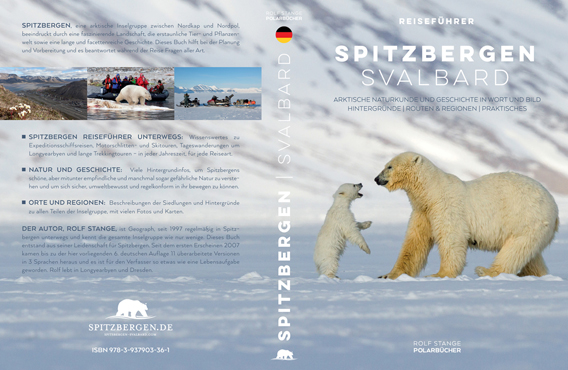
The 6th edition of the German guidebook Spitzbergen-Svalbard is now available The English and Norwgian versions were also updated recently and remain available.
As with the Norwegian and English versions, the new German edition has been comprehensively updated in almost all chapters, with improved text, maps etc. For further information, please visit the page dedicated to the German guidebook Spitzbergen-Svalbard on this website, where you can also order the book. It is also available on Amazon.de. Orders through this websites and reviews on Amazon (also for the English or Norwegian versions) will make the author happy.
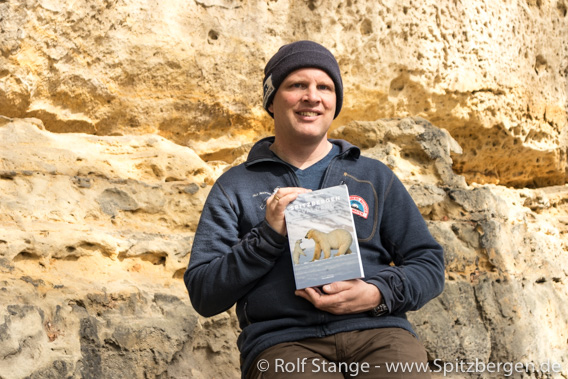
The author with the new, 6th edition of Spitzbergen-Svalbard (German).
News-Listing live generated at 2025/May/04 at 04:09:09 Uhr (GMT+1)




























